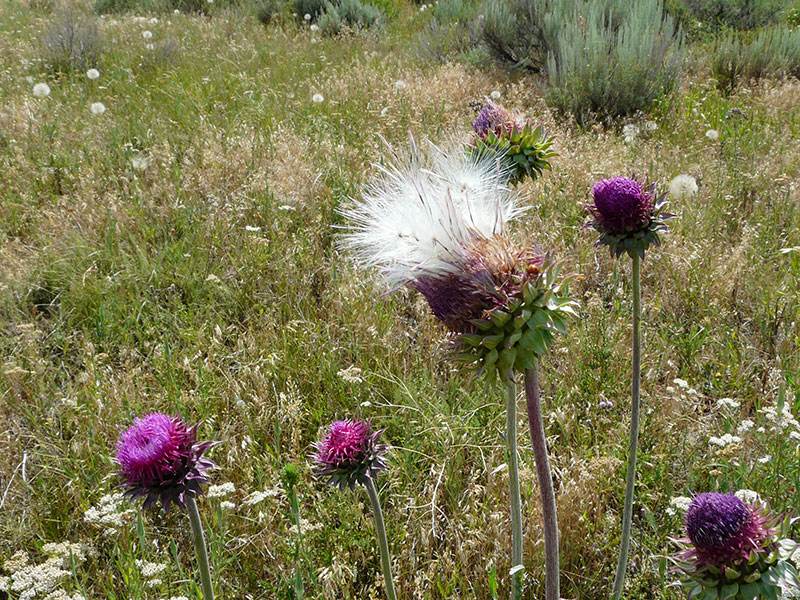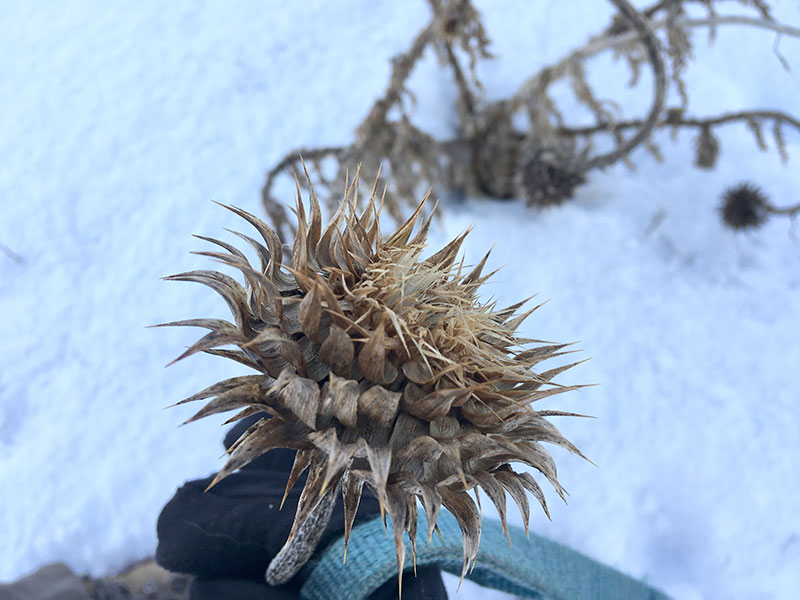Carduus nutans / musk thistle
- quite large, very purple flower heads
- spiny everything… leaves, stems, bracts
- biennial – large rosette of nasty leaves in first year
- dandelion-like fruit that flies away like the down of a thistle
- disturbed lands… pastures, wastelands, roadsides, construction sites
Also known as: nodding thistle, nodding plumeless thistle, bristle thistle (say that out loud to yourself, or to a little kid, just for fun)
See also: Cirsium vulgare (bull thistle); Cirsium arvense (Canada thistle)
If you have looked at the gallery pictures and checked above the line for the brief description, you will undoubtedly have found enough to be sure of this species. Even if you didn’t know its name, it was pretty much unmistakable. You may, therefore, quit here and go back to “the field”.
But in case it is raining or winter or you are settling in for the night, here are some more botanical bits.
Musk thistle is another in the long-ish list of species on this site whose taxonomy is less than clear. The Forest Service refers to musk thistle as “complex” rather than a single species. Nevertheless, it is one of the larger thistles, with flowering stems as much as 6 feet tall, and flowering heads as large as a tennis ball. Both of those maxima are rare in the Valley.
Musk thistle is a non-native, invasive – yea, noxious – weed. However, the blossoms are still spectacular. Each flower head contains hundreds of teeny disk florets; they have no ray florets. The heads typically hang over at 90˚ or more from vertical, at least when mature… hence the name “nodding thistle”.
The individual flower heads are large and sit alone at the top of a shoot, but with branching, individual plants may have 20 heads (the first ones to open are largest and produce the most seed). The heads are supported beneath by large numbers of bracts (phyllaries). These are large, triangular and spiny-tipped, giving young blossoms, especially, the look of a green and purple pinecone. As the flower heads grow and mature, the bracts that were initially green turn purple-ish.
As the blossoms open, the florets mature progressively from the outside in. Each floret is complete – male and female – and the pollen is sticky. This prevents wind dispersal and requires various insects, especially bees, to serve as vectors. On the other hand, the proximity of the anthers and stigmas makes for efficient self-pollination, and unlike for some species, seeds formed this way are quite viable.
Musk thistle seeds remain in the seed bank for many years. This makes it hard to get rid of. Pastures are particularly at risk of being overrun because the plant is not only unpalatable to livestock, but they actively avoid walking near it because of the spines.
Musk thistle is basically a biennial in the Valley. It is a pioneer species in disturbed environments, especially ruderal ones, i.e. where disturbance is combined with high nitrogen levels (think – cow pee and poop).
Most germination occurs in the fall, and the seedlings overwinter as prostrate rosettes. Depending on when germination actually happens and when flowering starts, these rosettes can grow to as much as 20 inches across. In the spring, the plants develop large, fleshy tap roots. The root crown and upper root tissues contain buds. Because of the phenomenon known as apical dominance, these are suppressed. They can, however, sprout following damage to plant shoot.
Both in the rosette stage and after bolting, bristle thistle leaves are dark green, and unbelievably bristly. The sharp yellow-ish spines are at the tips of all the lobes. The stems are also covered with spiny wings except for a few inches below the flower heads. The leaf surfaces range from waxy and hairless, to more or less hairy on top, and wooly on the veins below. Apparently, throughout North America, bristle thistle populations show huge variations in hairiness, leaf size, spine length, among other things.
The musk thistle fruit is an achene bearing short, thin seeds and connected to a hair-like pappus… basically like a big dandelion. The expected purpose of the pappus hairs is to aid in wind dispersal of the seeds. I say “expected” because it seems that fewer than 5% of the seeds remain attached to their pappus when it breaks off from the flowerhead and floats away. Indeed, fewer than 1% of wind-driven musk thistle seeds move more than 100 yards; most land, without pappus, much closer to their mom (US Forest Service).
But that is only the fraction of the seeds that are actually dispersed by the wind. Many musk thistle seeds fail to separate from the receptacle, so fruiting heads often simply fall to the ground with seeds. Thus, most seeds land really close to the mom. This is good, for us, in that it helps keep musk thistle from spreading rapidly, even into nearby favorable areas. A corollary to this is that most spread is caused by humans, and the cause of the “all hay must be inspected” signs at the state borders.
Musk thistle is most commonly found in heavily grazed land such as pastures, roadsides, building sites and other waste lands. It is quite fond of disturbance but not so much of wet, dry, or shady conditions. Indeed, locally dense plant litter strongly inhibits plant establishment and a couple inches of pasture cover can reduce germination by 90%.
Finally, although I don’t generally encourage putting things in your mouth without better advice than mine, some of the latter is available here, and so long as you know something is a thistle and can work around the spines, these are supposedly nice.
| Color | |
|---|---|
| Family | |
| Blossom size | |
| Inflorescence size | |
| Inflorescence type | |
| When? | |
| Where? |






